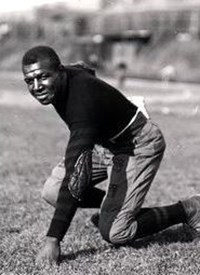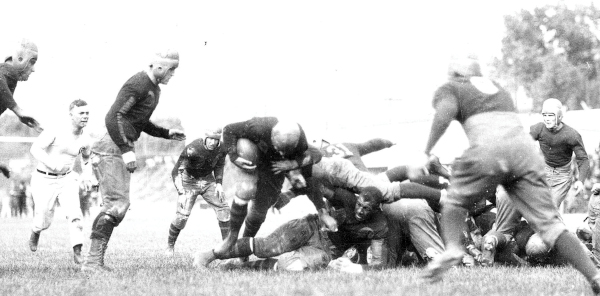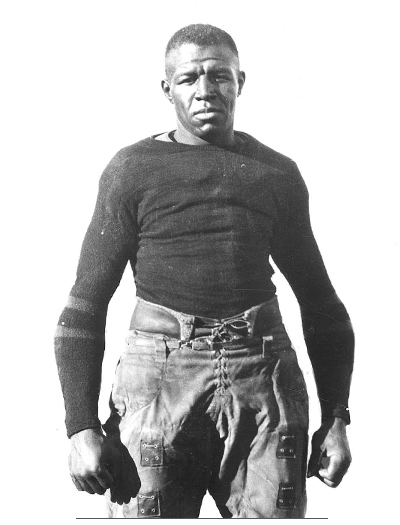Fred "Duke" Slater
Clinton High Class of 1914
 Duke
Slater moved to Clinton at the age of 13 in 1911. Slater played
football for Clinton High School and led them to the Iowa State
championship game versus West Des Moines High School in 1914. After
graduation in 1916, Slater attended the University of Iowa and was a
four year lettermen. Slater was a three time All-Big Ten selection
and a first team All-American in 1921.
Duke
Slater moved to Clinton at the age of 13 in 1911. Slater played
football for Clinton High School and led them to the Iowa State
championship game versus West Des Moines High School in 1914. After
graduation in 1916, Slater attended the University of Iowa and was a
four year lettermen. Slater was a three time All-Big Ten selection
and a first team All-American in 1921.
After graduation from Iowa, Slater played professional football for ten years. By the time of his retirement in 1931, Slater had achieved All-Pro status a total of six times. During his NFL career Slater never missed a game because of injury, starting in a total of 96 of the 99 games he played between the AFL and NFL.
Slater was a lineman for the Chicago Cardinals from 1926 to 1931 after stints with the Milwaukee Badgers and Rock Island Independents. He was one of 10 players selected as part of the Hall of Fame’s “Centennial Slate.”
Slater dominated as a collegian at Iowa before becoming the NFL’s first black lineman, and he often was the only nonwhite player on the field in the 1920s. He was named All-NFL four times as a two-way player, blocking for Hall of Famers such as Ernie Nevers, Jim Thorpe and Jimmy Conzelman and terrorizing offensive backfields as a defensive end.
Slater also earned his law degree from Iowa. In 1948, he was elected as a Municipal Court Judge in Chicago. In 1960, Slater became the first black member of the Chicago Superior Court, then the highest court in the city. Slater later moved to the Circuit Court of Cook County in 1964, following that institution's formation. Slater is also a member of the University of Iowa and College Football Hall of Fame.
Fred W. “Duke” Slater finally received a spot in the Pro Football Hall of Fame. The selection thrilled football experts familiar with the hidden history of African Americans in the earliest days of the sport. Former Bears Jim Covert and Ed Sprinkle were among the players who will be inducted Aug. 8 with Slater, who died in 1966.
After his football career, Slater became an attorney on the South Side and the first black judge to serve on the Cook County Superior Court.
The following is from the University of Iowa:
"A helmetless Duke Slater (at the bottom of the
pile) makes a block in Iowa's 10-7 home victory over Notre Dame in
October 1921. Iowa earned a perfect 7-0 record that year to become
one of the greatest teams in Hawkeye history.
Acentury has passed since Frederick Wayman "Duke" Slater (28LLB)
received his first national honors as an offensive tackle for Iowa's
football team. A sophomore during the 1919-20 season, Slater's best
years were yet to come, culminating as a senior when he led the
Hawkeyes to the Big Ten title in 1921, their first in over two
decades. Following that 7-0 season he was named a first-team
All-American.
Slater's many honors include election to the College Football Hall of Fame in 1951, the year of its opening. In 1972, the UI renamed a dormitory in his honor. This fall, a bronze-relief sculpture featuring Slater was unveiled as part of the renovations to the north stands at Kinnick Stadium, further ensuring his memory.

Frederick Wayman 'Duke' Slater PHOTO: FREDERICK W. KENT COLLECTION, UI LIBRARIES SPECIAL COLLECTIONS
Frederick Wayman "Duke" Slater
Historian Richard Breaux (98MA, 03PhD)—writing in former UI faculty
members Lena M. Hill and Michael D. Hill's excellent book, Invisible
Hawkeyes (University of Iowa Press, 2016)—noted that Slater and
other African American athletes at Iowa during the early 20th
century experienced the cruel paradox of adulation and
discrimination. While achieving fame for his outstanding athleticism
on the field, Slater—like other black students—was not permitted to
live in university housing and was subject to other forms of racism
during his academic career in Iowa City. The university's catalog,
policy handbook, and housing rules did not explicitly exclude
students, faculty, and staff on account of race. However, during the
early to mid-20th century, unwritten and long-enshrined
discriminatory customs and practices were enforced.
 In
1919, it was believed that there were perhaps 50 African American
students enrolled at Iowa, accounting for about 1% of the
overwhelmingly white campus' population at the time. Though a
Midwesterner—born in 1898 in Normal, Illinois, and a graduate of
Clinton, Iowa, High School—Slater no doubt experienced the paradox
of fame and scorn. Despite such barriers, Slater recognized
opportunities at Iowa for prospective students and helped recruit
other black athletes. His legacy reached into mid-century, more than
30 years after he graduated, when in 1955 five black players started
for Iowa under Coach Forest Evashevski, a number possibly unequaled
in the Big Ten at the time.
In
1919, it was believed that there were perhaps 50 African American
students enrolled at Iowa, accounting for about 1% of the
overwhelmingly white campus' population at the time. Though a
Midwesterner—born in 1898 in Normal, Illinois, and a graduate of
Clinton, Iowa, High School—Slater no doubt experienced the paradox
of fame and scorn. Despite such barriers, Slater recognized
opportunities at Iowa for prospective students and helped recruit
other black athletes. His legacy reached into mid-century, more than
30 years after he graduated, when in 1955 five black players started
for Iowa under Coach Forest Evashevski, a number possibly unequaled
in the Big Ten at the time.
Following graduation in 1922, Slater played professional football
for 10 seasons with teams in Milwaukee; Rock Island, Illinois; and
Chicago. During the offseason for several years in the 1920s, he
returned to Iowa City to study law, and in 1928 earned a Bachelor of
Laws degree. He settled in Chicago, becoming an assistant district
attorney and, in 1948, was elected as a judge to the city's
municipal court. He became the first black judge to serve on the
Superior Court of Chicago in 1960, and four years later joined the
newly formed Circuit Court of Cook County. He died in 1966."
Really cool video: https://www.youtube.com/watch?v=KG0Doco0FxA&feature=youtu.be
